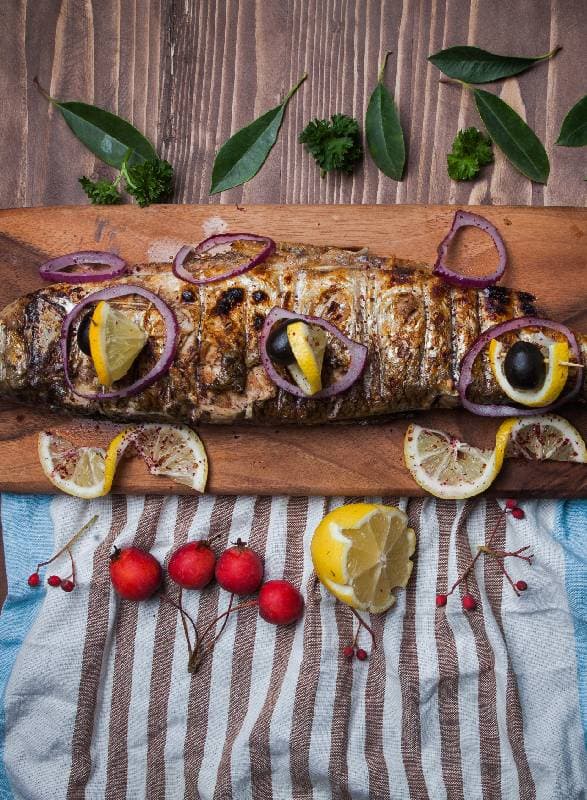In the culinary world, certain dishes and ingredients stand out for their unique flavors, health benefits, and versatility. Among these, sable fish, also known as black cod, holds a special place. Renowned for its buttery texture and rich omega-3 fatty acid content, sable fish has become a favorite among chefs and home cooks alike.

This article dives deep into the world of sable fish, offering insights into selecting and preparing this delightful seafood, alongside a collection of mouthwatering recipes that showcase its versatility. From air fryer delights to pan-fried wonders, we’ve got you covered. So, let’s embark on this flavorful journey and discover the culinary delights that sable fish has to offer.
Introduction to Sable Fish
What is Sable Fish?
Sable fish, a gem of the deep sea, is often hailed for its velvety texture and decadent flavor. Thriving in the cold, deep waters of the Pacific Ocean, this fish is a treasure trove of nutritional benefits, making it a sought-after ingredient in kitchens worldwide. Its high omega-3 fatty acid content not only promotes heart health but also plays a crucial role in brain function and inflammation reduction.
Nutritional Benefits of Sable Fish
Diving into the health benefits, sable fish is a powerhouse of nutrition. Rich in omega-3 fatty acids, it’s a heart’s best friend, offering protection against heart disease and stroke. These fatty acids are also celebrated for their anti-inflammatory properties, making sable fish a smart choice for those looking to combat inflammation and support overall health.
Why Sable Fish is a Culinary Favorite
Culinary enthusiasts adore sable fish for its versatility and ease of preparation. Whether grilled, baked, or broiled, it maintains its luscious texture, absorbing flavors beautifully. Its buttery flesh pairs wonderfully with a variety of marinades and seasonings, from bright citrus to savory miso, making it a perfect canvas for culinary creativity.
Sable fish’s unique qualities don’t just end at its taste and health benefits. Its sustainability is another reason to celebrate this seafood. By choosing sable fish, you’re opting for a sustainable seafood choice, contributing to the health of our oceans. For more on sustainable seafood choices, the Monterey Bay Aquarium Seafood Watch is an excellent resource.
As we explore the various facets of sable fish, from its nutritional benefits to its culinary versatility, it’s clear why this fish is a beloved ingredient in kitchens around the globe. Stay tuned as we delve into selecting and preparing sable fish, ensuring you have all the knowledge needed to bring out the best in this exquisite seafood.
Selecting and Preparing Sable Fish
How to Select the Best Sable Fish
Selecting the best sable fish starts with a keen eye and a bit of knowledge. Look for fish with bright, clear eyes and shiny, moist skin. The flesh should feel firm to the touch and smell fresh, like the ocean. If you’re buying frozen, ensure the packaging is intact, with no signs of freezer burn. Sustainable sourcing is key, so opt for suppliers who prioritize environmentally friendly fishing practices. For guidance on sustainable choices, the Monterey Bay Aquarium Seafood Watch offers invaluable insights.
Preparing Sable Fish for Cooking
Preparing sable fish for cooking is a straightforward affair that promises delightful results. Begin by rinsing the fish under cold water and patting it dry with paper towels. If you’ve purchased a whole fish, you may need to fillet it or ask your fishmonger to do it for you. Removing any remaining bones with tweezers ensures a seamless dining experience. To enhance its natural flavors, marinate the fish for a few hours or overnight in the refrigerator. Simple marinades using ingredients like lemon, ginger, and soy sauce not only add depth of flavor but also tenderize the fish, making it even more succulent.
Marinades and Seasonings for Sable Fish
The buttery texture of sable fish makes it an excellent candidate for a variety of marinades and seasonings. A simple marinade of lemon juice, olive oil, and herbs can elevate the fish’s natural flavors. For those seeking a richer profile, a miso glaze or a sweet and sour Vietnamese sauce can provide a delightful contrast to the fish’s creamy texture. Remember, the key to a perfect marinade is balance – a harmony of sweetness, acidity, and saltiness that complements the fish without overpowering it.
Incorporating LSI and NLP keywords such as “omega-3 fatty acids,” “sustainable seafood cooking,” and “cooking fish with citrus flavors” not only enriches the content but also aligns with SEO best practices, ensuring a comprehensive and engaging read.
As we move from selecting and preparing sable fish to exploring an array of recipes that highlight its versatility, keep in mind that the journey to a perfect dish begins with quality ingredients and a touch of creativity. Whether you’re an experienced chef or a home cook, sable fish offers a canvas for culinary exploration, promising dishes that are as nutritious as they are delicious. Stay tuned for the next section, where we’ll dive into the heart of sable fish cuisine with recipes designed to inspire and delight.
Sable Fish Recipes
Sable fish, with its buttery texture and rich flavor, is a versatile star in the kitchen. These recipes showcase the fish’s adaptability, from quick and easy meals to more elaborate dishes that are sure to impress.
3-Ingredient Air Fryer Miso Sable Fish
- Ingredients:
- Sable fish fillets
- Miso paste
- Mirin
- Step-by-Step Instructions:
- Mix miso paste and mirin to create a smooth marinade.
- Coat the sable fish fillets evenly with the marinade and let them sit for at least 30 minutes.
- Preheat the air fryer to 400°F.
- Place the marinated fillets in the air fryer basket and cook for about 10-12 minutes, or until the fish is flaky and slightly caramelized on the outside.
- Serve hot, garnished with a sprinkle of green onions or a squeeze of lemon, if desired.
- Serving Suggestions: Pair this dish with a side of steamed vegetables or a light salad for a balanced meal.
Fisherman Stew with Crispy Sable Fish
- Ingredients:
- Sable fish fillets, skin on
- A mix of vegetables (carrots, potatoes, onions)
- Tomato base for stew
- Herbs and spices
- Cooking Process:
- Sauté your choice of vegetables in a large pot until they start to soften.
- Add the tomato base and herbs, bringing the mixture to a simmer.
- In a separate pan, sear the sable fish skin-side down until crispy.
- Gently place the seared fish on top of the simmering stew, allowing it to cook through.
- Serve the stew hot, with the crispy fish fillet as the centerpiece.
- Tips for a Perfect Stew: A slow simmer is key to melding the flavors together while keeping the fish tender and juicy.
For a light and refreshing side dish to complement your sable fish meal, explore our easy-to-make, fresh, and flavorful seafood salad recipe.
Pan-Fried Sable Fish with Sweet & Sour Vietnamese Sauce
- Ingredients List:
- Sable fish fillets
- For the sauce: lime juice, fish sauce, sugar, garlic, chili
- Pan-Frying Techniques:
- Heat a pan over medium-high heat with a bit of oil.
- Once hot, place the sable fish skin-side down, cooking until the skin is crisp.
- Flip the fish carefully and cook until the flesh is opaque and flaky.
- Sauce Preparation: Mix lime juice, fish sauce, sugar, minced garlic, and chili to taste, adjusting the balance of sweet and sour to your liking.
Lemony Baked Sable Fish with Ginger and Mango Salsa
- Baking Instructions:
- Marinate the sable fish in a mixture of lemon juice, grated ginger, and a touch of olive oil.
- Bake in a preheated oven at 375°F for about 12-15 minutes, or until the fish is tender and flakes easily.
- Salsa Recipe: Combine diced mango, red onion, cilantro, and lime juice for a refreshing topping.
Broiled Miso Sable Fish
- Broiling Tips: Preheat the broiler and position the rack so the fish will be about 6 inches from the heat source. Watch closely to prevent burning.
- Marinade Recipe: A simple blend of miso, a touch of sugar, and soy sauce creates a rich glaze that caramelizes beautifully under the broiler.
Each of these recipes highlights the sable fish’s natural flavors, enhanced by various cooking methods and complementary ingredients. Whether you’re in the mood for something light and refreshing or rich and savory, there’s a sable fish recipe here to satisfy your cravings. Next, we’ll explore alternative cooking methods to keep your sable fish repertoire fresh and exciting.
Alternative Cooking Methods for Sable Fish
Exploring alternative cooking methods for sable fish opens up a world of culinary possibilities. Beyond the traditional pan-frying or baking, there are numerous ways to prepare this versatile fish, each method bringing out a unique aspect of its flavor and texture.
Grilling Sable Fish
- Grilling Tips:
- Preheat your grill to a medium-high heat.
- Lightly oil the grill grates and the fish to prevent sticking.
- Place the sable fish skin-side down on the grill. Grill for about 4-6 minutes per side, depending on the thickness of the fillets. The goal is to achieve a slightly charred exterior while keeping the interior moist and flaky.
- Serve immediately, with a drizzle of olive oil and a sprinkle of fresh herbs for an added burst of flavor.
Grilling sable fish not only imparts a smoky flavor but also creates a delightful contrast between the crispy skin and the tender flesh.
Poaching Sable Fish
- Tips for Cooking Sable Fish:
- Choose a poaching liquid. A simple court bouillon, a mixture of water, vinegar or wine, aromatics (like onion, carrots, and celery), and herbs, is a classic choice.
- Bring the poaching liquid to a gentle simmer. Avoid boiling, as high heat can cause the fish to become tough.
- Gently add the sable fish fillets to the simmering liquid and cook for about 10 minutes, or until the fish is opaque and flakes easily with a fork.
- Carefully remove the fish from the liquid and serve with a light sauce or a squeeze of lemon for a refreshing touch.
Poaching is a gentle cooking method that keeps sable fish moist and tender, making it a great option for those looking for a healthy and flavorful meal.
Sous Vide Sable Fish
- Cooking Process:
- Season the sable fish fillets with salt, pepper, and any other desired seasonings.
- Place the fillets in a vacuum-sealed bag or a ziplock bag using the water displacement method.
- Set your sous vide machine to the desired temperature – around 130°F (54°C) for sable fish – and cook for 30 to 45 minutes.
- Once done, you can quickly sear the fish in a hot pan for a crispy exterior if desired.
Sous vide cooking offers precise temperature control, resulting in perfectly cooked sable fish every time. This method ensures that the fish remains juicy and flavorful, with a texture that’s unparalleled.
Steaming Sable Fish
- Steaming Techniques:
- Fill a pot with a few inches of water and bring to a boil.
- Place the sable fish in a steamer basket or on a plate that fits inside the pot without touching the water.
- Cover and steam for about 8-10 minutes, or until the fish is cooked through.
- Enhance the steamed fish with a light soy sauce or ginger scallion oil for an Asian-inspired twist.
Steaming is a healthy cooking method that preserves the natural flavors and nutrients of sable fish, resulting in a delicate and moist texture.
Each of these alternative cooking methods offers a unique way to enjoy sable fish, catering to different tastes and dietary preferences. Whether you’re looking for a quick weeknight dinner or a leisurely weekend feast, sable fish adapts beautifully to various cooking techniques, ensuring a delicious and nutritious meal every time.
FAQs
As sable fish continues to gain popularity in kitchens around the world, several questions frequently arise regarding its preparation, cooking, and nutritional benefits. Here are some of the most common queries answered to help you make the most of this versatile seafood.
Best Season to Buy Sable Fish?
- Sable fish, also known as black cod, can be caught year-round, but its peak season is from March to November. During this time, the fish is at its freshest, offering the best quality and flavor.
Can Sable Fish Be Frozen?
- Yes, sable fish freezes exceptionally well due to its high fat content, which helps maintain its texture and flavor. Properly wrapped and stored, sable fish can be kept in the freezer for up to three months without compromising its quality.
Alternative Fish If Sable Fish Isn’t Available?
- If sable fish is not available, Chilean sea bass is a good alternative due to its similar buttery texture and rich flavor. Halibut can also be substituted, offering a firmer texture but still retaining the ability to absorb flavors well.
Conclusion
Sable fish, with its luxurious texture and profound nutritional benefits, stands out as a culinary delight. Its versatility across a spectrum of cooking methods—from grilling and poaching to more innovative approaches like sous vide—makes it a favorite among chefs and home cooks alike. This guide has traversed the journey from selecting and preparing sable fish to exploring a variety of recipes that highlight its unique flavor profile.
Moreover, understanding the best practices for buying, storing, and substituting sable fish ensures that you can enjoy this exquisite seafood year-round, regardless of the season. The FAQs section aimed to address common inquiries, making your culinary experience with sable fish as seamless and enjoyable as possible.
As we conclude, remember that cooking sable fish is not just about following recipes but also about embracing creativity and experimentation. Each method and recipe offers a foundation on which you can build, adapt, and innovate, making each dish uniquely yours. Whether you’re a seasoned chef or a curious cook, sable fish provides a canvas for culinary exploration, promising dishes that are as nourishing as they are delicious. So, dive into the world of sable fish and let your culinary adventure begin.


